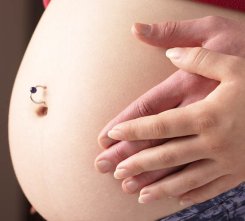21 June 2005
Eggs And Sperm Made From Stem Cells
by Kate Melville
 Scientists in the UK now claim it is entirely possible that eggs and sperm can be created from human embryonic stem cells (HESCs), and experiments conducted in at least two other countries appear to either complement or support this claim. Representatives from the UK, Belgium and Australia presented their research on HESCs at the 21st annual European Society for Human Reproduction and Embryology conference, held on Monday the 20 June. Collectively, their research shows that the groundwork for therapeutic cloning and assisted reproduction has been laid.
Scientists in the UK now claim it is entirely possible that eggs and sperm can be created from human embryonic stem cells (HESCs), and experiments conducted in at least two other countries appear to either complement or support this claim. Representatives from the UK, Belgium and Australia presented their research on HESCs at the 21st annual European Society for Human Reproduction and Embryology conference, held on Monday the 20 June. Collectively, their research shows that the groundwork for therapeutic cloning and assisted reproduction has been laid.
People concerned with the ethical dilemmas associated with HESC research should especially take note of these latest developments. Behrouz Aflatoonian, a PhD student in Professor Harry Moore's laboratory at the Center for Stem Cell Biology, University of Sheffield, UK, believes that the research solves the practical and ethical problems associated with obtaining human samples of primordial germ cells (PGCs), which are the ancestral cells that eventually form eggs and sperm (gametes).
At the conference, Professor Moore said, "if we could produce eggs from HESCs they could also be used for therapeutic cloning (somatic nuclear replacement) circumventing the need for eggs from patients who donate them, as this is a major limitation of this technique at the moment. We would then have completed the circle of making HESCs from eggs that came from HESCs - what came first the chicken or the egg?!" This is significant, since the potential to create more stem cells for further research may mean improved treatments for patients suffering from a range of diseases.
Of course, revolutionary findings such as these are almost always grounded in a quagmire of reality. It's not that the science isn't possible, Moore and his PhD candidate have witnessed embryonic bodies "expressing" some of the genes found in human PGCs within a two week period. However, Mr. Aflatoonian says that embryoid bodies can separate into many tissue types, so deciding on which cells to develop into PGCs and how to encourage them to grow into gametes could still prove to be a puzzle. "Producing functional gametes is much more difficult, because we have to recreate for the cultured cells the environment of the developing follicle for egg development or the tissue of the testis for sperm," said Mr. Aflatoonian.
Fret not Mr. Aflatoonian. It seems that other researchers from around the world are also working toward similar ends. A research team led by Dr. Orly Lacham-Kaplan, from the Monash Immunology and Stem Cell Laboratories, Australia, has developed a simple, repeatable system to support the development of embryonic stem cells into ovarian structures containing eggs. So far the system has only involved mouse embryonic stem cells. The intention is to use the new system to develop eggs for sterile women that contain the women's own genetic material, where an egg's genetic material is removed and replaced with that of a sterile woman." Some people just don't have eggs or sperm and there's little we can do for them except use donor material. The ability to develop eggs in vitro could primarily assist sterile women but could also reduce the ongoing strain on donor egg programs," said Dr. Lacham-Kaplan's.
It seems certain, then, that Dr. Lacham-Kaplan would have found the research of a Belgian team of scientists at the conference very interesting. Bjorn Heindryckx, a PhD student at the Infertility Centre at Ghent University Hospital, Belgium, and his colleagues, claimed that they are the first to use a system similar to the one described by Dr. Lacham-Kaplan. First, the nuclear apparatus that holds the genetic information and chromosomes of an oocyte (egg cell) is removed. The team then injects the empty oocyte with the nuclei taken from somatic cumulus1 cells (i.e. non-germ cells) of another person - a process known as non-autologous nuclear transfer. After time for nuclear re-programming the oocytes were artificially activated by incubation in a medium containing calcium ionophore, which enabled the injected nucleus to prepare for the first embryonic division. This is apparently the "first report describing the development of cloned human embryos using in vitro matured oocytes and non-autologous transfer via a conventional method of nuclear transfer," said Mr. Heindryckx.
The Belgian, Australian and UK scientific teams all consider therapeutic human cloning as a means of sustaining further research into genetic defects and for the treatment of infertile couples. However, the research also allows investigation into how both the ovary and testis develops. Professor Moore believes that this is an important part of the research as, "Many scientists believe that environmental chemical pollutants that mimic the action of hormones (so called endocrine disrupting chemicals) might interfere with human development at this stage and cause congenital abnormalities, infertility and possibly cancer (in particular testicular cancer). By developing suitable tests with embryonic stem cells as they differentiate to germ cells we can investigate the action of these chemicals in the laboratory." All the teams involved said that the developments occurred in the lab, and that practical applications are likely a long way off.
Source: Media releases - European Society for Human Reproduction and Embryology, Research Australia
